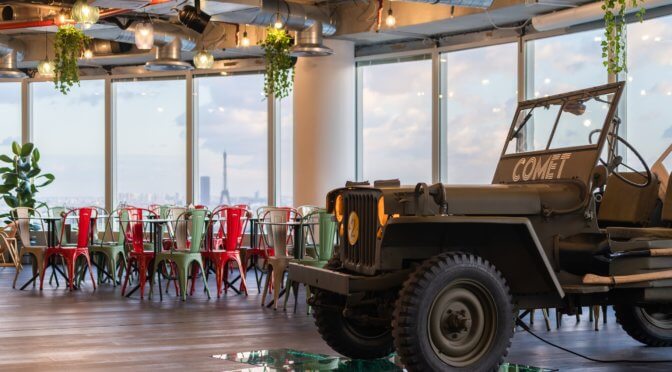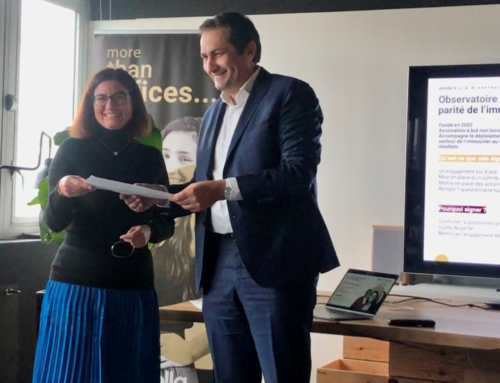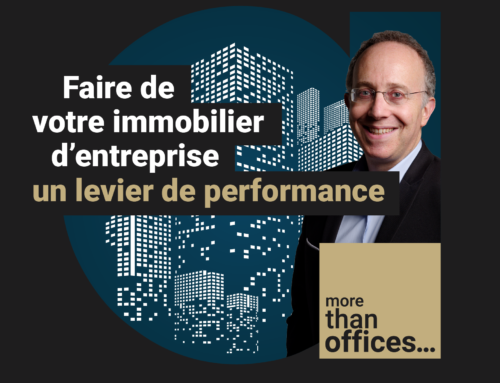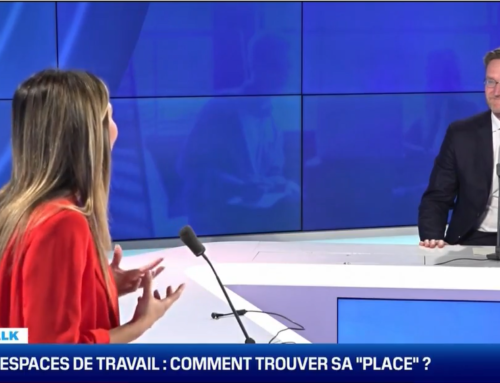Is the object the new catalyst for appropriating workspaces?

Photo: Jeep on display in the middle of the food court at Comet La Défense. Photo credit: Jared Chulski.
The health crisis has certainly accelerated the transformation of our offices and changed our relationship to the workspace in general. The gradual return initiated by certain companies leads to a double observation:
- The offices are deserted,
- Employees and managers alike are in favour of appropriate teleworking (i.e. between 1 and 3 days per week depending on the job and the organisation).
This situation is prompting some companies to embark on projects to transform work spaces:
- To reduce areas that have become quite useless,
- To strengthen the attractiveness of offices and create new uses for them, based on collaboration and the strengthening of social links.
This transformation may involve setting up a flex-office organisation. This approach generally requires support for teams because it can be experienced as anxiety-provoking. For some, it marks a loss of identity, a loss of reference points: MY place, MY business, MY photos, MY trophies, etc.
But is it really a total loss of reference points, or more a shift from an individual to a collective reference point?
From personal landmark to collective emblem?
To compensate for this sense of loss, the personalisation of shared collective spaces is one of the answers provided by some companies today.
Personalization, yesterday orchestrated between intuitue personae and individual initiatives, is now giving way to a controlled and personalized corporate branding within which one element will play many roles both internally and externally: the Object!
The Object is now becoming a standard symbol of a company's transformation
During moves and changes in work spaces, workshops related to change management raise the question of the object. It has become an icon of the company or the team. The choice of an object proves to be a powerful act when it is carefully and symbolically chosen to embody a village, a district, a direction... and it becomes a real catalyst for change and the collective!
From the sole decorative appeal to the object that conveys meaning and emotion
The choice of an object is guided by its capacity to give meaning. It allows stories to be told, generates an undeniable extra soul, and conveys strong emotions.
When it is displayed, its sensory added value immerses the visitor or employee in the space they are discovering or occupying.
No more decorative objects or works of art chosen for arbitrary aesthetic reasons. The object can illustrate a landmark, such as a historical or symbolic reference for certain societies. It is the iconic dimension of the object that interests us here.
Like this architect's office which has found an Eames lounge chair, chosen as much for its comfort as for its status as a "design piece", and whose model is from the same year of birth as the head of the company or agency. In this case, the object offers more than just a nice seat; it also establishes a social and sectoral affiliation.
The unique object raised to the status of emblems
Space designers sometimes use the Object to provide a strong visual impact ("wow effect") in the reception area or in the main living space of the company. Companies can then invest in the tailor-made manufacture of an object that will make a statement. A unique piece!
This object can provide a sense of belonging and pride. Comet Meetings, a company known for its ultra-decorated venues, chose a US Army Jeep as the iconic object for its La Défense site in its main area. A striking and noticed object!
In this type of case, the object becomes emblematic and totemic, and all the employees make it their own. It is shown, talked about, photographed with, published on social networks... It carries the spirit of a company, of a team, of a tribe... of a collective.
The Object becomes the company's standard.
From the object of desire to the embodiment of transformation
The Object is therefore a bearer of meaning and emotion, bringing an extra touch of soul and always its decorative force. It undoubtedly helps to desacralise the tertiary space. It becomes the object of desire, the object of attention, the spearhead of internal transformation and sometimes one of the supports of external communication for certain companies.
It is also increasingly a real lever for change. The interest in the question of the choice of object in change management workshops is obvious.
The reflections provided by the participants of a workshop on the transformation of spaces lead to much more than the simple choice of an object... they federate and push individuals to question themselves, to put into perspective, to illustrate and to symbolise the transformation of their company... The object also becomes a new vector of reflection, which is valid as much for the choice that will be made as for the path towards this choice.
Article written by :
- Ludovic Legendre, Parella, Partner MRICS
- Nicolas Flachot, Parella, Style and Creative Director






